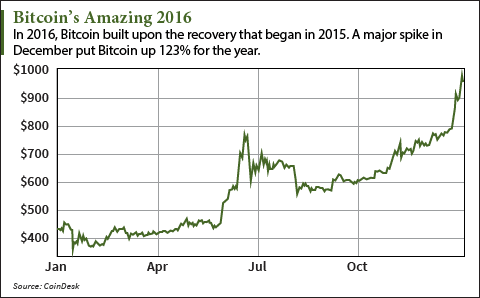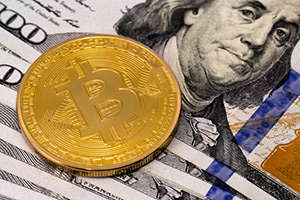"Why is the Bitcoin price rising past $1,000?" is a question on a lot of lips this week. And for good reason.
The cryptocurrency had an astounding run in December, soaring more than 30% from $742 to $968. In the first two days of 2017, the price of Bitcoin is up nearly 6% more, to $1,025 on the CoinDesk Bitcoin Price Index.

That's the highest level for the price of Bitcoin since December 2013, when the digital currency had started its year-long retreat from its all-time high of $1,156.06.
For all of 2016, the Bitcoin price gained 123%, easily outperforming other assets such as stocks (the Standard & Poor's 500 Index rose 9.5%), crude oil (up 45%), and natural gas (up 59%). The closest currency to Bitcoin was the Russian ruble, up 17% against the U.S. dollar.
It's the second year in a row the digital currency has topped all other assets. In 2015 the price of Bitcoin rose 35%.
Trending: How Small Investors Can Take on Wall Street... And Win
Even so, the recent surge in the Bitcoin price - particularly December's steep rise - took many by surprise. It's left many searching for an answer about what's driving such aggressive price increases.
Of course, part of the answer is that there isn't just one answer...
Why the Bitcoin Price Has Been Rising So Fast
Multiple factors combined in the second half of 2016 to set Bitcoin up for its current run to $1,000. Such as:
- The halving: On July 9, the reward Bitcoin miners get for solving a block was halved by the network from 25 bitcoins to 12.5 bitcoins. The Bitcoin price spiked in June in anticipation of this reduction in supply, then dropped back in late July. But as I pointed out then, the full impact of the last halving (in November 2012) was delayed for several months.
 Global currency worries: As fiat currencies have shown increasing fragility, a digital currency like Bitcoin has grown more attractive. Both South Sudan and Venezuela had 2016 inflation rates of about 475%. People also worried about the global war on cash, with India invalidating 86% of its banknotes in circulation virtually overnight.
Global currency worries: As fiat currencies have shown increasing fragility, a digital currency like Bitcoin has grown more attractive. Both South Sudan and Venezuela had 2016 inflation rates of about 475%. People also worried about the global war on cash, with India invalidating 86% of its banknotes in circulation virtually overnight.
- Political Uncertainties: The Brexit vote, the increasing frequency of terrorist attacks, and the rise of nationalism worldwide have all contributed to an uneasy feeling among investors. In such times people look for safe havens, and in 2016 Bitcoin joined gold and silver as a safe haven
- Big Banks Embracing Blockchain: Although venture capital investment in Bitcoin slowed in 2016, financial institutions continued to move ahead in their efforts to adopt Bitcoin's blockchain technology to suit their own purposes. That validation has helped reassure those on the fence about investing in Bitcoin while encouraging more industries to consider how they might benefit from digital currencies.
Now with all that as a backdrop, add one more incredibly potent ingredient: China.
How China Has Fueled the Rise in the Price of Bitcoin
In general the rise in the price of Bitcoin in 2016 has mirrored the decline in the value of the Chinese yuan.
China's influence over what happens with Bitcoin has grown dramatically over the past several years. Most of the Bitcoin miners are located there. And more than 90% of Bitcoin trading by volume takes place on the Chinese Bitcoin exchanges, although those numbers are thought to be inflated.
One the reasons Bitcoin has grown popular in China is that it offers a haven from the falling yuan. Chinese businessmen and middle-class citizens see Bitcoin as one of the few options they have to preserve their wealth.
Don't Miss: A Gold Price Prediction for the Coming Bull Run: $5,236 an Ounce
Some Chinese are also likely using Bitcoin to skirt that nation's capital controls. And that monthly rate at which capital is leaving China continues to accelerate. In August, about $27.7 billion worth of yuan left China. In September, that number rose to $44.7 billion. In November it was $69.2 billion.
The Chinese are concerned about further yuan devaluations as well as increased tightening of capital controls.
Just last Friday the People's Bank of China (PBOC) announced that the threshold for Chinese banks to report yuan-denominated cash transactions will drop from 200,000 yuan to just 50,000 yuan (about $7,200).
This is why the Bitcoin price in yuan has been tracking higher than its price in U.S. dollars lately. Today (Monday) Bitcoin has been trading at about 7,320 yuan - the equivalent of $1,053.
Fears of what the PBOC will do next will keep worried Chinese buying Bitcoin, which in turn will maintain upward pressure on the price of Bitcoin, at least in the short term.
But what does 2017 hold in store for Bitcoin? Here's what some top Bitcoin influencers recently told Money Morning...
Where the Bitcoin Price Is Headed in 2017
[mmpazkzone name="in-story" network="9794" site="307044" id="137008" type="4"]
Nearly every expert we talked to in December foresaw more Bitcoin adoption in 2017, which is a primary long-term catalyst for the Bitcoin price. Many also saw further woes for fiat currencies driving more people to Bitcoin.
"Micropayment models will start to gain traction, and Bitcoin will increasingly become a global currency risk hedge as currency wars flame up. India opened up a can of worms, and other countries will follow their example of a war on cash," said Alan Silbert, founder and CEO of BitPremier.
Although their forecasts for the price of Bitcoin in 2017 vary widely, all believe it will end the year significantly higher.
For example, Silbert predicted a Bitcoin price of $1,450 (Bitcoin was trading below $900 at the time). The most optimistic expert was Tim Draper, founding partner of the Draper Fisher Jurvetson (DFJ) venture capital firm and best known for buying up all 30,000 bitcoins in the June 2014 auction of confiscated Silk Road bitcoins. He forecasts a price of $10,000.
But most eyes are now focused on Vinny Lingham, who has drawn attention for several spot-on Bitcoin price predictions. Lingham, a Bitcoin Foundation board member, said in May that Bitcoin would hit $1,000 by the end of 2016. He was off by less than 24 hours.
"Just figured out why I was out by a day on my $1k Bitcoin prediction... 2016 was a leap year - I forgot to factor in that extra day!" Lingham joked on Twitter.
Lingham also predicted Bitcoin's 2013 run to $1,000 when it was trading at just over $100. In 2014 he warned that the Bitcoin price would languish through a long period of consolidation below $550.
For 2017, this "Bitcoin Oracle" sees the big gains continuing.
"I think it could break $3,000 during the year and maybe settle in the $2,000-plus zone," Lingham said.
Up Next: The Securities and Exchange Commission is likely to approve the Winklevoss Bitcoin Trust (BATS: COIN), an exchange-traded fund based on Bitcoin, in the first half of 2017. A Bitcoin ETF will make it much easier to invest in the digital currency, but as this ETF will break new ground, investors will have a lot of questions. That's why Money Morning has put together this Winklevoss Bitcoin ETF Guide for Investors.
Follow me on Twitter @DavidGZeiler or like Money Morning on Facebook.
About the Author
David Zeiler, Associate Editor for Money Morning at Money Map Press, has been a journalist for more than 35 years, including 18 spent at The Baltimore Sun. He has worked as a writer, editor, and page designer at different times in his career. He's interviewed a number of well-known personalities - ranging from punk rock icon Joey Ramone to Apple Inc. co-founder Steve Wozniak.
Over the course of his journalistic career, Dave has covered many diverse subjects. Since arriving at Money Morning in 2011, he has focused primarily on technology. He's an expert on both Apple and cryptocurrencies. He started writing about Apple for The Sun in the mid-1990s, and had an Apple blog on The Sun's web site from 2007-2009. Dave's been writing about Bitcoin since 2011 - long before most people had even heard of it. He even mined it for a short time.
Dave has a BA in English and Mass Communications from Loyola University Maryland.



